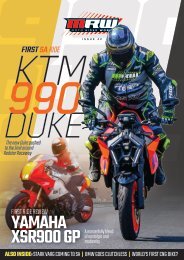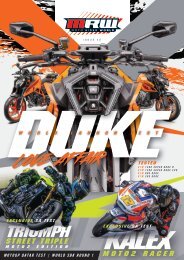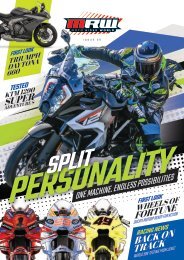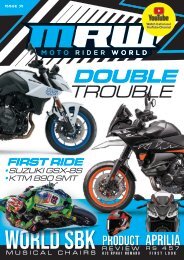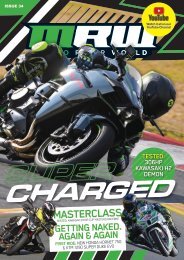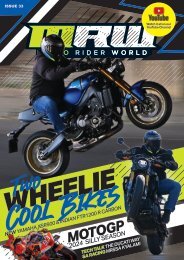You also want an ePaper? Increase the reach of your titles
YUMPU automatically turns print PDFs into web optimized ePapers that Google loves.
The GS platform’s enhanced suspension<br />
system represents a significant step forward<br />
and for me is one of the most important updates<br />
for 2024, particularly with the redesigned front<br />
Telelever suspension. BMW has introduced<br />
variable front spring rates by employing a<br />
dual-spring setup, improving adaptability. The<br />
Evo Telelever features a redesigned upper fork<br />
bridge, connected pivotally and rotatably to a<br />
steering shaft tube via a radial swivel bearing.<br />
This engineering decision replaces two ball<br />
joints with a flex plate, resulting in a more<br />
robust front end, reduced steering friction, and<br />
minimized flex. BMW’s newly developed Evo<br />
Telelever goes beyond simply replacing ball<br />
joints with a steel plate. BMW has a history of<br />
pioneering electronic suspension technology<br />
which features on the majority of their premium<br />
models, although they have been a couple of<br />
steps behind specialist companies like Ohlins<br />
and WP in recent years. With the 1300GS,<br />
BMW aimed to address this gap and we think<br />
that they most certainly have done so. While<br />
damping adjustments were traditionally the<br />
main focus of BMW’s suspension systems<br />
in the past, the new front shock in the Evo<br />
Telelever introduces a smaller spring within the<br />
reservoir, achieving the coveted variable spring<br />
rate, a breakthrough for BMW and something<br />
that I am sure they will implement on future<br />
models throughout their range.<br />
The Evo Telelever is complemented by the Evo<br />
Paralever, which BMW says has a significantly<br />
stiffer connection to the chassis for better<br />
traction. Also, the swingarm bearing is arranged<br />
off-axis to the axis of rotation of the cardan shaft<br />
joint, while the arm itself is longer, thanks to<br />
the reduced engine length. The suspension is<br />
matched to a new Dynamic ESA as an optional<br />
extra (you can bet pretty much all GSs sold at<br />
the dealership will come fitted with Dynamic<br />
ESA). It still runs in the rider/rider with luggage/<br />
two riders/two riders with luggage parameters<br />
but allows the spring rate to be adjustable<br />
depending on riding mode. Adaptive vehicle<br />
height control and sports suspension are<br />
available as optional equipment.<br />
Good suspension means nothing without a solid<br />
chassis. For 2024, this is a new design using<br />
a sheet metal main frame and cast aluminum<br />
subframe, marking a huge departure from<br />
the tubular steel subframe design seen on<br />
generations of GS’s. This also contributes to the<br />
massive weight saving achieved on the 1300GS.<br />
The main frame is much slimmer, lighter, and<br />
more tightly wrapped around the new motor,<br />
although BMW says the front and rear weight<br />
distribution is the same as the 1250, which itself<br />
had excellent high- and low-speed stability.<br />
On the subject of slowing down, the GS gets<br />
Integral ABS Pro and Dynamic Brake Pro as<br />
standard equipment alongside new four-piston<br />
radially-mounted calipers up front and a twopiston<br />
floating caliper on the rear. The calipers<br />
are top-of-the-line Brembos just branded as<br />
BMW, so of course they are brilliant. The Integral<br />
ABS Pro system engages both front and rear<br />
brakes regardless of whether only the front brake<br />
lever is pulled, offering enhanced braking control.<br />
In both on-road and off-road modes, it allows for<br />
front brake pressure application even without<br />
touching the front lever. When off-road, riders can<br />
choose to lock up the rear wheel if desired. On<br />
the other hand, Dynamic Brake Control prevents<br />
unintended throttle application during braking<br />
by reducing reverse torque reaching the rear<br />
wheel. This aids in optimizing brake performance<br />
without causing rear wheel chattering,<br />
particularly when combined with the Motor Slip<br />
Regulation (MSR) system mentioned earlier.<br />
Whether on the road or on dirt as with the old<br />
1250GS you can grab a handful of front brakes<br />
and come to a sudden and safe stop quicker<br />
than on any other motorcycle I have ridden.<br />
RIDING THE NEW 1300 GS<br />
For many BMW GS owners, road performance<br />
is just as crucial, if not more so, than off-road<br />
capabilities, as not all GS bikes see dirt roads<br />
much like those expensive Land Rovers you see<br />
around town and on school runs that never see<br />
dirt roads. The cockpit feels roomy yet more<br />
compact compared to the 1250 model, with a






